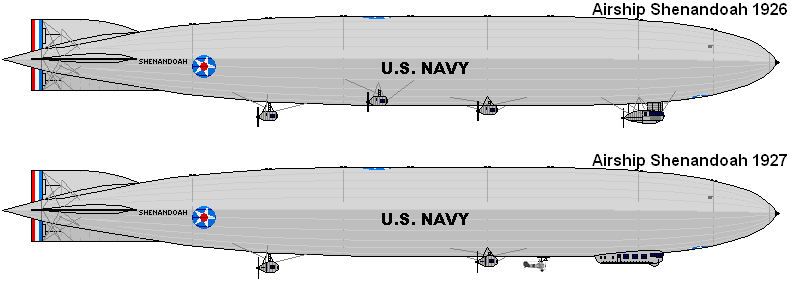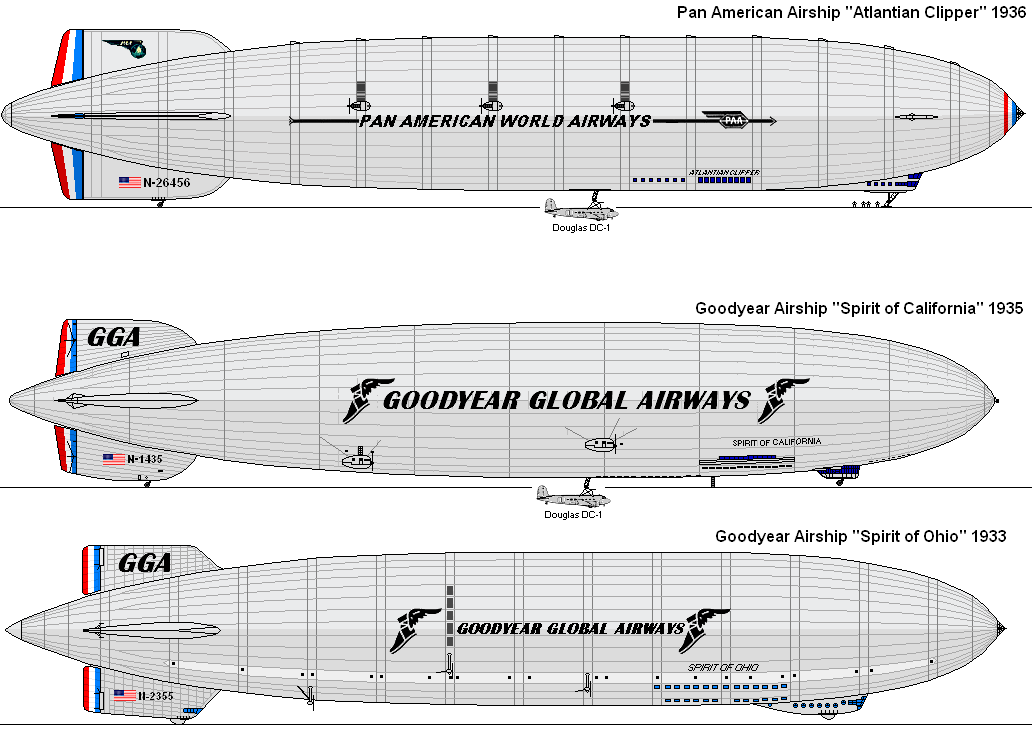AIRSHIPS
United
States

The
Army airship Roma was built in Italy and was a
"semi-rigid" design. It had a rigid keel which
supported the engines, control car, etc... while the envelope was
supported by gas pressure and ballonets like a blimp. She was
lost in 1921 apparently when a structural failure jammed her
controls and sent her crashing into power lines near her base
near Hampton Roads Va. Filled with hydrogen; she exploded in
flames, killing thirty-four crew. The disaster was a major reason
for the movement from hydrogen to helium in American airships..

America’s
first home-grown rigid airship, the Shenandoah was based on
German designs from World War One. She was ripped in two in a
severe thunderstorm over Ohio in 1925. The lower drawing shows
suggested modifications. One was a revised control car connected
to the hull instead of suspended below it. Most of those killed
in her crash were in the control car which fell off in the
disaster. It was also proposed to give her more powerful engines,
reducing them in number from five to three, and there were also
plans to carry aircraft.

ZR-2
never received a name, being lost before even reaching the United
States. Intended for high altitude flight, this British built
airship broke in two, exploded, and crashed in 1921 while
undergoing trials. For the purposes of an alternate history sim I
take part in, I named her Susquehanna since in the sim she
survives to enter US service. In the sim she undergoes a refit
similar to the Shenandoah in the late 1920’s. Her control
car is enlarged, new engines installed, and she is equipped to
carry an airplane.

The
Los Angeles was America’s most successful and longest lived
rigid airship. Built in Germany by Zeppelin, the L.A.served in
one capacity or another for nearly fifteen years, though she was
grounded from 1933 until her scrapping in 1939.During her
construction it was suggested that she be lengthened, but it was
not done for financial reasons.

The
relatively tiny ZRC-2 is hard to classify. While it had an
internal structure to its envelope, it also used gas and air
pressure to hold its shape. Its main claim to fame is that it was
the only all-metal airship ever to fly in the U.S. However, the
Navy had little interest in the design and produced no follow ons.
This picture is at twice the scale of the other airships on this
page.

The
Army airship RS-1 was the only American built
"semi-rigid" airship built. Parts were fabricated by
Goodyear in Akron, then shipped to Scott Field Illinois for final
construction. She suffered from some structural problems with her
nose that limited her speed. After being disassembled for
repairs, it was decided instead to scrap her.



The
first drawing is of the Akron design as planned. The main
difference between it and the final ship as built is the tail fin
design. It was decided that it was necessary to be able to see
the ventral fin from the control car, so the fins were modified.
This was probably a fatal mistake since it was later determined
that the new fin design was structurally weak and was blamed for
the loss of the Macon in 1935. The Akron crashed in a storm in
1933, possibly due to faulty altimeter readings that let her get
too low and strike the water. It was suggested that the Macon be
lengthened while under construction. This would improve her range
considerably. It was considered too expensive and was not done.

The
Charlotte is my hypothetical design for an Akron/Macon follow-on
based on the civilian version shown below. It could carry up to
ten aircraft based on information about converting the civilian
ship to military use.

A
hypothetical training ship to replace the Los Angeles in the
early 1930's.

The
“Sacramento” is my name for a Navy ZRS design from the
late 1930’s. It was intended as a true flying aircraft
carrier, with the ability to carry nine bombers, rather than as a
reconnaissance platform.

This
is a design for a Navy training airship from the late
1930’s. It would have been able to carry three aircraft.

A
military version of Goodyear's 1939 Passenger airship proposal.

The
Long Island is from Rowan Partridge’s novel ZRS, an
alternate history story set during the opening months of World
War Two in the Pacific. The Long Island, and her sister, the Mercer
Island, are enlarged, Metalclad descendants of the Akron and Macon.

A
totally hypothetical high-speed, Metalclad carrier. The control
car retracts into the hull to lower wind resistance. The bow
planes are from a Goodyear patent from the early 1930’s.
They would aid maneuverability, especially at low altitudes and
in rough weather where they could serve as dampers. At low
altitude they could be used to lift the bow instead of pushing
down the stern like normal tail planes do when an airship wants
to climb. Such a device may well have saved the Akron since it is
believed that she struck the ocean with her tail while trying to
climb from very low altitude.

A
hypothetical civilian version of the Long Island. Something this
big could easily carry well over 100 passengers.


Goodyear
had several plans for passenger airships both before and after
World War Two. The top drawing is loosely based on a picture in a
Goodyear advertisement from the late 1940’s. The second is
simply an American version of the LZ-131 (stretched Hindenburg),
while the third drawing is of a planned civilian variant of the Macon
capable of carrying 80 passengers. My thanks go to Mark Foxwell
for providing information on the design so I could revise the
drawing. The markings are purely fictional. The DC-1’s
hanging underneath the Spirit of California and the Pan Am ship
would not be carried internally. My idea was to use them for
transferring passengers and cargo to facilities that might not be
able to handle a large airship or for priority deliveries and
such. The last drawing is of a proposed Goodyear airship from
1939 for the New York to Rio route.
Germany

Zeppelin’s
most successful passenger airship, the Graf Zeppelin sailed
around the world and made numerous crossings of the Atlantic from
Germanyto North and South America. It was finally scrapped at the
start of World War Two.

Probably
the most famous and infamous airship ever, the Hindenburg was the
largest airship ever built but was destroyed in 1937 while
landing at Lakehurst. New Jersey. The cause of the accident was
never absolutely determined. Theories include leaking hydrogen
igniting, a fuel leak, ignition of the flammable outer skin, and
outright sabotage.

The
Graf Zeppelin II was to replace the original Graf Zeppelin in the
Zeppelin airship fleet. Like the Hindenburg, she was intended to
use helium, but the U.S. refused to sell it to Nazi Germany.
Completed after the loss of Hindenburg, the Graf Zeppelin II was
never used as a passenger ship, but did conduct espionage flights
around England and Poland.

“Peter
Strasser” is my name for the planned follow-on to the
Hindenburg and Graf Zeppelin II. It was basically just a
stretched modification of the earlier ships. Construction of some
structural components began in the late 1930’s, but was soon
cancelled.
United
Kingdom

Built
by Vickers, the R100 was clearly the superior design in a design
competition for a passenger airship. She flew only one passenger
flight, to Canadain 1930. After the R101 disaster, she was
scrapped. The middle drawing shows a proposed modification to the
passenger accommodations and the control car. Some cabins would
be moved into the control car from the hull. The lower drawing
shows the ship lengthened, which was proposed after her flight to
Canadaand before the R101 crash.

Built
by the British government, the R101 was clearly inferior to the
R100. She was so overweight that not only was she lengthened to
add a gas bag, but the rigging securing the bags in place was
loosened to allow them to hold more hydrogen. This allowed the
bags to chafe against the structure. The outer cover was also of
poor quality. While on her maiden passenger voyage to India, she
crashed and exploded in France. It is believed that the covering
over her forward gas bags tore loose in the storm, allowing the
bags to be damaged and causing her to crash. The lower drawing
shows her in an alternate timeline from the novel “ZRS”
by Rowan Partridge. In the book, R101 is lengthened and converted
to helium. During the Japanese attack on Singapore, she serves as
a hospital ship. Suffice to say, the Japanese simply considered
the red crosses to be large targets and she does not survive
long.
Italy

Built
by Italian designer Umberto Nobile (designer of the Roma and also
helped design the RS-1), the Norge flew across the Arctic in 1926
from Norway to Alaska. It was the first undisputed crossing of
the pole by aircraft, since there remains controversy about
Byrd's flight a few days earlier. The later, similar, airship
Italia was lost in 1928 while making a similar flight.
Airship
Links
Airship
An excellent reference site with pages on various nations’
airship efforts, bibliographies, links, and a plethora of other
information.
Zeppelin
A sister site to the one above dealing strictly with designs from
the Zeppelin Company.
Airships Online The site
of the Airship Heritage Trust of the United Kingdom. The site is
a comprehensive look at the airships of the British Empire. An
absolutely tremendous site!
Lakehurst Historical Society
Covers the history of the airship base in Lakehurst, New Jersey. Excellent
photo galleries, especially of the Shenandoah and Los Angeles.
Moffett Field Museum
Deals with Moffett NAS in Sunnyvale, California, home to the Macon.
Excellent photo gallery.It also has a small store.
The Naval
Historical Center has pages dedicated to each of
America’s rigid airships: The Shenandoah,
ZR-2,
Los
Angeles, Akron,
and Macon.
A
website on German Airships. It’s mostly in Polish, but
has excellent graphics.
The
Airship Image Library. An excellent series of galleries, many
of them postcards.
The Zeppelin Museum in
Friedrichshafen. The main museum in the world when it comes
to airships, and specifically Zeppelins. The museum includes a
full sized reproduction of part of the Hindenburg’s
passenger cabin.
Back


























